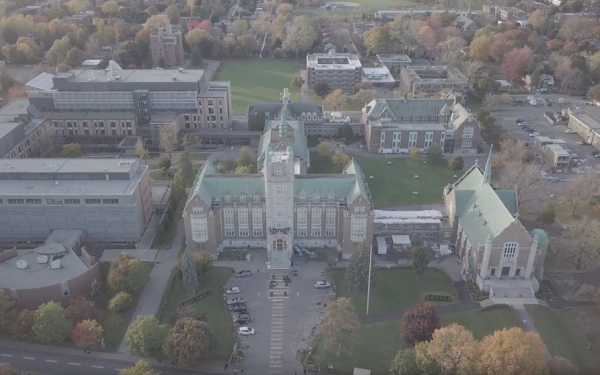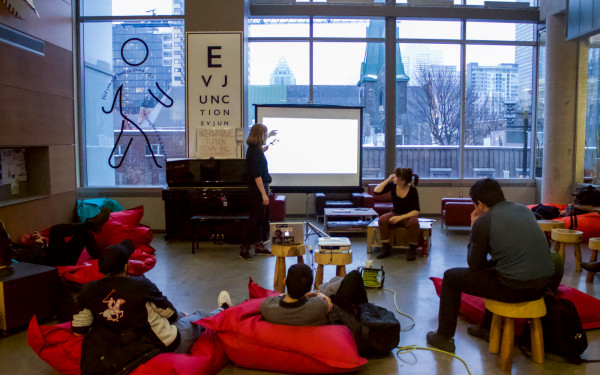Knotting together identity, heritage and community
Allegra Hu shares the ancient art of Chinese knot-making through workshops and jewelry
Allegra Hu’s two cats bat at a purple cord as they finish a handmade talisman. Outside, it’s cold and grey; but inside, Hu is deep in their creative flow.
Music by Kelela plays softly in the background, and nothing is getting in the way of wrapping up their latest commission—a housewarming gift for the mother of longtime client and friend, Leila Fabing. Fabing approved Hu’s mockups, and now, after five days of careful work, the piece is nearly done. It’s one of Hu’s favourite commissions to date, they share.
Born and raised in the greater Boston area, Hu moved to Montreal three years ago to study studio arts at Concordia University. They began with painting and drawing but eventually gravitated toward fibre arts and jewelry making—a shift that led to the creation of Ai Li Jewelry, their small business specializing in Chinese knot jewelry.
Called after their Chinese name, ‘ai li’ directly translates to “love beauty,” which is exactly what Hu hopes to imbue in each piece they create.
“The knots have been a motif I’ve always seen as a kid,” Hu said. “Usually, they're up during Lunar New Year or on clothes—traditional garments specifically—and I've always thought they were very beautiful.”
Traditionally, Chinese knots are used as talismans to ward off evil spirits. Unlike other forms of jewelry-making, knotting is an accessible craft. All you need is a cord, a few pins and a pinboard.
Looking to reconnect to their heritage and spotlight a craft they’ve always found beautiful, Hu decided to make a zine on Chinese knotting. They worked on it with the help of the Fine Arts Reading Room, Concordia’s student-run art library and resource centre. They turned to YouTube tutorials, taught themself each knot by hand and translated that learning into a handmade guide.
Curious about how others would connect with the craft, Hu applied for a leadership grant from the Montreal organization Jeunesse Lambda, which supports LGBTQIA2S+ youth activities, to host a knot-making workshop. After receiving the funding, they were able to host their first session in 2023. For Hu, sharing the practice, especially with others in the diaspora, warmed their heart.
“There's a pretty large Chinese community in Montreal, and even people from different diasporas were drawn to knot making,” Hu said. “Even if it wasn't really part of their culture specifically, it was just a craft that they were curious about.”
While Hu had some teaching experience in the past as a game design instructor, their knotting workshop was their first time leading a hands-on atelier. They handed out copies of their zine to encourage participants to learn at their own pace.
“It was hard. I left with one knot,” Fabing said after attending the workshop. “It’s difficult; it takes a lot of patience and intuition, almost.”
As Hu’s art progressed, their knot-making blended into their jewelry-making.
“I grew up in Southeast Asia. You see those knots everywhere, and I've never seen them set in jewelry,” Fabing said.
Hu pitched their business idea to Fabing as a way to challenge the perception of the “Made in China” label—a phrase often linked to mass production and poor quality. Instead, Hu aimed to reclaim it by creating traditional Chinese knot pieces that are meticulously crafted, time-consuming and rooted in skill and intention. That same care is reflected in every part of Hu’s process, including their thoughtful approach to materials.

Nikoiya Wile, a customer and friend of Hu’s, highlighted the intentionality behind their work.
“They're always using either silver or steel, making sure it's hypoallergenic and locally sourced beads,” Wile said.
Hu was able to grow their business while studying full-time at Concordia. According to them, being a student at the university and selling during pop-up events on campus had its advantages.
“There’s this economy of Concordia students who really support and love the arts,” they said. “I found that my art-making and my art schooling blended really well together.”
Through their small business, Hu was able to accrue a large enough following to be selected for their first art residency at the Maison de la culture Notre-Dame-de-Grâce on Monkland Avenue last fall.
Their project, titled “Season of Change,” stemmed from Chinese mythology and folklore. Through two canvas scrolls, they reinterpreted the ancient tale of the Chinese Zodiac race. The story is about how animals had to earn their place on the Zodiac by competing against each other. Hu chose to focus on the story of the mighty dragon who sacrificed being in first place by helping a farmer whose barn was on fire by summoning rain in one scroll, on the other the dragon is represented saving the rabbit from drowning in the river.
They were also able to raise over $300 for the local anti-imperialist food solidarity group, NDG Food Not Bombs.
“It was cool that I had enough of a following that I was actually able to raise some money for that collective and make the residency an actionable thing,” Hu said.
The momentum didn’t come without its own set of challenges. During the artist’s residency, Hu was making art full-time and consequently developed an injury in their wrist.
“I was overworking myself,” Hu said. “I wasn’t taking care of my body properly; [it was] in order to produce as much as possible.”
According to Hu, their body was sending them a clear message: to slow down. They realized that perfection was not necessary; instead, they could focus on learning, designing and experimenting.
Getting their business off the ground wasn’t easy, either. Hu juggled their studies while attending four to five market pop-ups a month.
While the process wasn’t easy—physically nor emotionally—it led to moments that reminded Hu of why they started their craft.
Last year, they were commissioned to make large-scale knots for the community garden of the Hôpital chinois de Montréal.
They designed two colourful knots—one red, one purple—meant to be seen from the hospital’s windows. The goal was to brighten up the place while also protecting the space.
“The folks who were in the hospital could look outside and feel some kind of familiarity and comfort from the knots,” Hu said.
It has now been a year and a half since Hu founded Ai Li Jewelry. For Fabing, who’s followed Hu’s journey from the beginning, the evolution is clear.
“I don't think they would have been able to create such a beautiful knot for my mom [...] like a year and a half ago,” Fabing said. “But through their workshops and through all the research that they do, and trying to innovate on their designs, they've gotten really, really skilled.”
Hu would like to hone their garment-making skills, a natural extension of their practice that could open up new possibilities for blending form, function and tradition.
Their next pop-up is on April 10 with the Garnet Key Society at the Concordia Student Union lounge.


_600_832_s.png)




